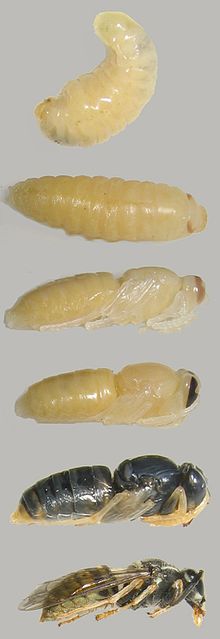Holometabolic insects
| Holometabolic insects | ||||||||||||
|---|---|---|---|---|---|---|---|---|---|---|---|---|

Western honey bee ( Apis mellifera ) |
||||||||||||
| Systematics | ||||||||||||
|
||||||||||||
| Scientific name | ||||||||||||
| Holometabola | ||||||||||||
| Burmeister , 1835 | ||||||||||||
| Orders | ||||||||||||
|

The holometabolous insects (Holometabola; . AltGr ὅλος holos "entirely", "completely", and μεταβολή metabolic "change") are a group of insects , and are within the flying insects (pterygota) to the Neuflüglern (Neoptera). They include all insects that undergo a complete metamorphosis in their development from a larva to a pupa to a fully grown insect ( imago ). They comprise over three quarters of all known insects.
Within the flying insects, the holometabolic insects are opposed to the hemimetabolic insects (Hemimetabola), in which the pupal stage is missing (incomplete transformation).
The holometabola are also called endopterygota (literally about "inner winged"). This refers to the development of the wing systems within the body. In contrast, the wings of the Hemimetabola develop on the outside of the body (they are therefore also called Exopterygota).
description
The three developmental stages larva, pupa and adult insect (imago) are not similar and often have a different way of life.
Due to the complexity of the characteristic “holometabolic development”, the holometabolic insects (in contrast to the hemimetabolic insects) are well established as a natural group ( monophylum ) within the insects. The main correspondence is the complete transformation of the insect in the pupa, which is built in as a resting stage between the last larval stage and the adult animal. In the original species, the pupa is always motionless and does not eat any food. It draws the energy for the conversion process from the storage proteins that are stored in the cells of the fat body and are transported by the hemocytes , the blood cells of the insects. Similar processes can also be observed in adults, who also do not eat any food in many species.
The structures of the wings and genital appendages, often also those of the legs , are located in the larvae of the holometabolic insects in vesicles under the body wall, the so-called imaginal discs . The compound eyes are also created in such imaginal discs and replace the larval point eyes after pupation.
Taxonomy and systematics
The holometabolic insects include some of the best known and most biodiverse taxa of insects. A list of the orders contained here can be found in the taxobox opposite.
The phylogenetic system of the holometabolic insects is currently based almost exclusively on classic features of morphology, physiology and development. Genetic data play a subordinate role as they are not yet available for most groups.
| Holometabola |
|
||||||||||||||||||||||||||||||||||||||||||||||||
|
|
literature
- Bernhard Klausnitzer: Insecta (Hexapoda). In Westheide, Rieger (Hrsg.): Special zoology part 1: single-cell and invertebrate animals. Gustav Fischer Verlag, Stuttgart · Jena 1997; P. 659ff.
Web links
- http://www.naturspektrum.de/text/text_holometabolie.php Info (comparison of holometabolism ↔ hemimetabolism)